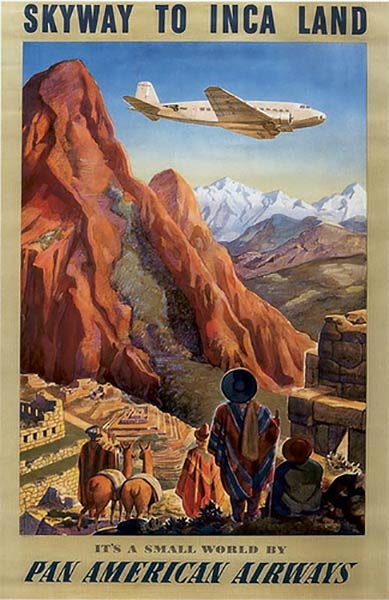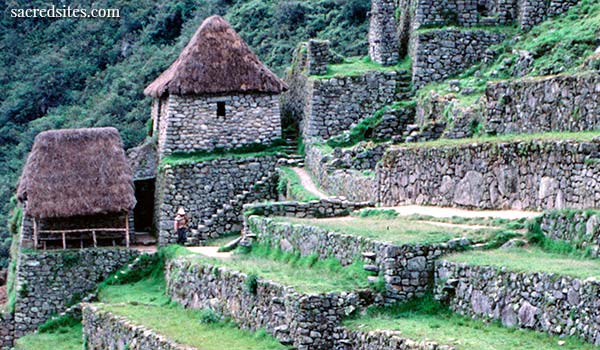
- Machu Picchu is a 15th-century Inca site located on a ridge between the Huayna Picchu and Machu Picchu mountains in Peru. It stands 7,970 feet (2,430 meters) above sea level on the eastern slope of the Andes and overlooks the Urubamba River hundreds of feet below.
- Machu Picchu means "Old Peak" in the indigenous language of Quechua. Most experts believe that Machu Picchu was constructed around 1400 AD as a royal estate for the Incan ruler Pachacútec Inca Yupanqui, the ninth ruler of the Inca. An empire builder, Pachacuti initiated a series of conquests that would eventually see the Inca grow into a South American realm that stretched from Ecuador to Chile. Machu Picchu was later abandoned during the Spanish conquest of the Inca Empire in 1532. Over time it became famous as the legendary Lost City of the Inca.
- The Incas were superb craftsman and experts at using a building technique called ashlar in which blocks of quarried granite stone – some weighing as much as 50 tons - were so precisely cut as to fit together tightly without mortar. These incredible civil engineering techniques reduced the affects of frequent earthquakes. Machu Picchu's construction is especially amazing considering the Inca did not use draft animals, iron tools, or the wheel. It is a mystery how the massive blocks of stone were moved up steep terrain and through dense bush, but it is generally believed that hundreds of men were used to haul the stones up.
- The site covers 80,000 acres (32,500 hectares) and is divided in an urban area and an agricultural area. It is estimated that 60% of the construction was underground, including deep building foundations and crushed rock for drainage. The urban area comprised an upper part where the royalty lived and temples were built, and a lower part for workers quarters and warehouses.
- The most important structures at Machu Picchu are the Temple of the Sun (also called the Torreon), the Temple of Three Windows, the Temple of the Condor, and the Intihuatana Stone. The Intihuatana Stone (meaning ‘Hitching Post of the Sun’) was an astronomical observation device used to determine the precise periods for different festivals and celebrations of importance in the Inca religion.
- Terraced fields on the edge of the site were once used for growing crops, likely maize and potatoes. Machu Picchu had access to springs for water and enough terraced and irrigated land to grow food for around four times as many people as ever lived there. Although Machu Picchu has a wall and simple gateways, it doesn’t appear to have been set up with military purposes in mind, and there is no evidence that a battle of any sort was fought there.
- The ruins of Machu Picchu were discovered in 1911 by Yale archaeologist Hiram Bingham. However, the accepted history that Bingham was the first outsider to see Machu Picchu has been challenged. The strongest contender is the German engineer Augusto Berns who may have been to the site 40 years prior to the American. There are also maps that show the ruins dating back to 1874.
- The ruins of Machu Picchu are 75 miles northwest of the city of Cuzco, former capital of the Inca Empire. There are two ways to get to the ruins. One is by train from Cuzco, which takes approximately four hours, with a stop at the old Inca site of Ollantaytambo. The other is by trekking along the so-called Inca Trail, which generally takes about four days. Each year there is a race along the Inca Trail, which at 26 miles is very nearly a marathon. The current record is three hours and 26 minutes.
- Visitors to Machu Picchu may stay in hotels at the foot of Machu Picchu peak in the town of Aguas Calientes or at a luxury hotel alongside the ruins. For those staying in Aguas Calientes there are numerous buses driving uphill to the ruins and it is also possible to walk to the ruins in less than two hours. The best time to visit Machu Picchu is in May or June when temperatures are mild and precipitation is minimal. The rainy season is between November and March.
- Rising 1180 feet over the ruins of Machu Picchu is the peak of Huayna Picchu with temples and terraces on its summit. According to local legends, the top of the mountain was the residence of the high priest who every morning before sunrise would walk to Machu Picchu to signal the coming of the new day. From the summit, a second trail leads down to the Great Cavern and the Temple of the Moon, both with fine masonry. The number of daily visitors allowed to enter Huayna Picchu is restricted to 400. Advance purchase of tickets will guarantee admission.
- When Bingham found the ruins of Machu Picchu he uncovered a treasure trove of artifacts that he took with him to Yale University, including mummies, bones, ceramics and precious metals. The Peruvian government has long requested the university to return these items, which are estimated to number over 40,000.
- Since its rediscovery over 30% of Machu Picchu has been reconstructed to give a better idea of how it originally looked and restoration continues today. It was named a Peruvian Historical Sanctuary in 1981 and UNESCO classified it as a World Heritage Site in 1983.
- Thirty minutes walk from the town of Aguas Calientes the excellent Museo de Sitio Manuel Chávez Ballón has information in Spanish and English on the archaeological excavations of Machu Picchu.
- The name of the archaeological site Machu Picchu is sometimes misspelled as machu pichu, macchu picchu, machu piccu, machupicchu, macu picchu, macho picchu, machu piccho, machu picch, macha picchu, machu piccuh, mach picchu. The correct spelling is Machu Picchu.

Machu Picchu Terraces
 Martin Gray is a cultural anthropologist, writer and photographer specializing in the study of pilgrimage traditions and sacred sites around the world. During a 40 year period he has visited more than 2000 pilgrimage places in 165 countries. The World Pilgrimage Guide at sacredsites.com is the most comprehensive source of information on this subject.
Martin Gray is a cultural anthropologist, writer and photographer specializing in the study of pilgrimage traditions and sacred sites around the world. During a 40 year period he has visited more than 2000 pilgrimage places in 165 countries. The World Pilgrimage Guide at sacredsites.com is the most comprehensive source of information on this subject.For Additional Information: